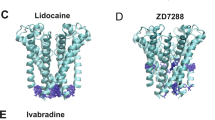Summary
Based on the gate-related receptor hypothesis, an analysis of kinetics of AN-132, a new antiarrhythmic agent, blockade of cardiac sodium channels and the gate-related receptor which is bound by the drug was performed by computer simulation. Model-predicted apparent rates of onset of AN-132 (30 μmol/L) blocking were 0.051, 0.038, and 0.034 AF−1 at stimulation frequencies of 1.0, 2.0 and 3.0 Hz, respectively. The time constant of recovery from block by AN-132 at resting potential -90 mV was 39.5 s. These findings are in agreement with those experimental data documented. The analysis of gate-related receptor shows that AN-132 binds the inactivation gate-related receptor, and the binding and unbinding are modulated by the inactivation process.
Similar content being viewed by others
References
Sakai K, et al. Antiarrhythmic effects of a novel diacine derivative, AN-132, on several animal models of cardiac arrhythmias. Tohoku J Exp Med, 1987, 151:443
Chihara S, et al. Frequency and voltage dependent effects of AN-132, a new class I anti-arrhythmic agent, on Vmax of action potential upstroke in guinea pig ventricular muscles. Cardiovasc Res, 1988, 22:648
Wu YJ, Fang DC. Mechanisms of action of sodium channel blocker: Gate-related receptor hypothesis. Sci Sin (Part B), 1991, (10):1068
Luo C, Rudy Y. A model of the ventricular cardiac action potential: Depolarization, repolarization, and their interaction. Circ Res, 1991, 68:1501
Campbell TJ. Kinetics of onset of rate-dependent effects of Class-I antiarrhythmic drugs are important in determining their effects on refractoriness in guinea-pig ventricle, and provide a theoretical basis for their subclassification. Cardiovas Res, 1983, 17:344
Wu YJ, Fang DC. Computer simulation of metoclopramide block of cardiac sodium channels. J Tongji Med Univ, 1992,12(2):94
Ono K, et al. Effects of AN-132, a novel antiarrhythmic lidocaine analogue, and of lidocaine on membrane ionic currents of guinea-pig ventricular myocytes. Naunyn-Schmiedeberg’s Arch Pharmacol, 1989, 339:221
The Cardiac Arrhythmia Suppression Trial (CAST) Investigators. Preliminary report: effect of encainide and flecainide on mortality in a randomized trial of arrhythmia suppression after myocardial infarction. N Engl J Med, 1989,321:406
Ranger S, et al. Amplification of flecainide-induced ventricular conduction slowing by exercise: A potentially significant clinical consequence of use-dependent sodium channel blockade. Circulation, 1989,79:1000
Mazzanti M, Defelice LJ. Na channel kinetics during the spontaneous heart beat in embryonic chick ventricle cells. Biophys J. 1987, 52:95
Author information
Authors and Affiliations
Rights and permissions
About this article
Cite this article
Yue-jin, W., Da-chao, F. AN-132 block of cardiac sodium channels: A gate-related receptor analysis. Journal of Tongji Medical University 13, 1–5 (1993). https://doi.org/10.1007/BF02886583
Received:
Issue Date:
DOI: https://doi.org/10.1007/BF02886583




